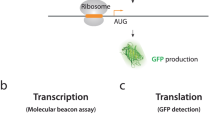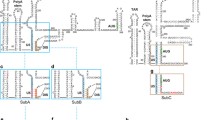Abstract
AU-rich elements in 5’ untranslated region (UTR) are known to increase translation efficiency by recruiting S1 protein that facilitates the assembly of ribosomes. However, AU-rich elements also serve a binding site for Hfq protein, RNase E, etc. To investigate their roles in translation, mRNAs containing either an AU-rich element, originated from sodB 5’-UTR or a non-AU-rich element were constructed. The non-AU-rich elements were designed to retain the thermodynamics of the AUrich element-containing mRNAs to reduce structural effect on translation. The AU-rich element increased mRNA translation and knock-down of S1 protein decreased the translation of AU-rich element-containing mRNAs, confirming the essential role of S1 protein in translation. When their mRNA levels were measured in hfq-deleted cells, those containing a non-AU-rich element and a high AU-content N-terminal coding sequence decreased, representing an auxiliary role of Hfq in translation, specifically in mRNA protection. Interestingly, despite of decreased mRNA level in hfq-deleted cells, protein production was increased, implying the involvement of unknown factors in translation. Consequently, these results suggest that actively translating ribosomes recruited by S1 protein at an AU-rich element stabilize mRNAs from degradation. In the absence of S1 protein, Hfq protein protects mRNAs from degradation. Moreover, AU-rich elements can be used for improved protein production.
Similar content being viewed by others
References
Young, C. L., Z. T. Britton, and A. S. Robinson (2012) Recombinant protein expression and purification: A comprehensive review of affinity tags and microbial applications. Biotech. J. 7: 620–634.
Nallamsetty, S. and D. S. Waugh (2007) A generic protocol for the expression and purification of recombinant proteins in Escherichia coli using a combinatorial His6-maltose binding protein fusion tag. Nat. Protoc. 2: 383–391.
Wang, X., B. Zhou, W. Hu, Q. Zhao, and Z. Lin (2015) Formation of active inclusion bodies induced by hydrophobic self-assembling peptide GFIL8. Microb. Cell Fact. 14: 88.
Hwang, P. M., J. S. Pan, and B. D. Sykes (2014) Targeted expression, purification, and cleavage of fusion proteins from inclusion bodies in Escherichia coli. FEBS Lett. 588: 247–252.
Salis, H. M., E. A. Mirsky, and C. A. Voigt (2009) Automated design of synthetic ribosome binding sites to control protein expression. Nat. Biotechnol. 27: 946–950.
Na, D., S. Lee, and D. Lee (2010) Mathematical modeling of translation initiation for the estimation of its efficiency to computationally design mRNA sequences with desired expression levels in prokaryotes. BMC Syst. Biol. 4: 71.
Bonde, M. T., M. Pedersen, M. S. Klausen, S. I. Jensen, T. Wulff, S. Harrison, A. T. Nielsen, M. J. Herrgard, and M. O. A. Sommer (2016) Predictable tuning of protein expression in bacteria. Nat. Methods. 13: 233–236.
Seo, S. W., J. S. Yang, I. Kim, J. Yang, B. E. Min, S. Kim, and G. Y. Jung (2013) Predictive design of mRNA translation initiation region to control prokaryotic translation efficiency. Metab. Eng. 15: 67–74.
Barrick, D., K. Villanueba, J. Childs, R. Kalil, T. D. Schneider, C. E. Lawrence, L. Gold, and G. D. Stormo (1994) Quantitative analysis of ribosome binding sites in E. coli. Nucleic Acids Res. 22: 1287–1295.
Allert, M., J. C. Cox, and H. W. Hellinga (2010) Multifactorial determinants of protein expression in prokaryotic open reading frames. J. Mol. Biol. 402: 905–918.
Na, D. and D. Lee (2010) RBSDesigner: software for designing synthetic ribosome binding sites that yields a desired level of protein expression. Bioinformatics. 26: 2633–2634.
Lotz, T. S. and B. Suess (2018) Small-molecule-binding riboswitches. Microbiol. Spectr. 6: 6.4.26.
Kaberdin, V. R. and U. Bläsi (2006) Translation initiation and the fate of bacterial mRNAs. FEMS Microbiol. Rev. 30: 967–979.
Hook-Barnard, I. G., T. J. Brickman, and M. A. McIntosh (2007) Identification of an AU-rich translational enhancer within the Escherichia coli fepB leader RNA. J. Bacteriol. 189: 4028–4037.
Van Assche, E., S. Van Puyvelde, J. Vanderleyden, and H. P. Steenackers (2015) RNA-binding proteins involved in post-transcriptional regulation in bacteria. Front. Microbiol. 6: 141.
Nakagawa, S., Y. Niimura, K. Miura, and T. Gojobori (2010) Dynamic evolution of translation initiation mechanisms in prokaryotes. Proc. Natl. Acad. Sci. USA. 107: 6382–6387.
Valentin-Hansen, P., M. Eriksen, and C. Udesen (2004) The bacterial Sm-like protein Hfq: a key player in RNA transactions. Mol. Microbiol. 51: 1525–1533.
Hoekzema, M., C. Romilly, E. Holmqvist, and E. G. H. Wagner (2019) Hfq-dependent mRNA unfolding promotes sRNA-based inhibition of translation. EMBO J. 38: e101199.
Na, D., S. M. Yoo, H. Chung, H. Park, J. H. Park, and S. Y. Lee (2013) Metabolic engineering of Escherichia coli using synthetic small regulatory RNAs. Nat. Biotechnol. 31: 170–174.
Schmittgen, T. D. and K. J. Livak (2008) Analyzing real-time PCR data by the comparative C(T) method. Nat. Protoc. 3: 1101–1108.
Komarova, A. V., L. S. Tchufistova, E. V. Supina, and I. V. Boni (2002) Protein S1 counteracts the inhibitory effect of the extended Shine-Dalgarno sequence on translation. RNA. 8: 1137–1147.
Komarova, A. V., L. S. Tchufistova, M. Dreyfus, and I. V. Boni (2005) AU-rich sequences within 5’ untranslated leaders enhance translation and stabilize mRNA in Escherichia coli. J. Bacteriol. 187: 1344–1349.
Geissmann, T. A. and D. Touati (2004) Hfq, a new chaperoning role: binding to messenger RNA determines access for small RNA regulator. EMBO J. 23: 396–405.
Folichon, M., V. Arluison, O. Pellegrini, E. Huntzinger, P. Régnier, and E. Hajnsdorf (2003) The poly(A) binding protein Hfq protects RNA from RNase E and exoribonucleolytic degradation. Nucleic Acids Res. 31: 7302–7310.
Baek, Y. M., K. J. Jang, H. Lee, S. Yoon, A. Baek, K. Lee, and D. E. Kim (2019) The bacterial endoribonuclease RNase E can cleave RNA in the absence of the RNA chaperone Hfq. J. Biol. Chem. 294: 16465–16478.
Park, H. S., Y. Ostberg, J. Johansson, E. G. H. Wagner, and B. E. Uhlin (2010) Novel role for a bacterial nucleoid protein in translation of mRNAs with suboptimal ribosome-binding sites. Genes Dev. 24: 1345–1350.
Mitta, M., L. Fang, and M. Inouye (1997) Deletion analysis of cspA of Escherichia coli: requirement of the AT-rich UP element for cspA transcription and the downstream box in the coding region for its cold shock induction. Mol. Microbiol. 26: 321–335.
Massé, E. and S. Gottesman (2002) A small RNA regulates the expression of genes involved in iron metabolism in Escherichia coli. Proc. Natl. Acad. Sci. USA. 99: 4620–4625.
Večerek, B., I. Moll, T. Afonyushkin, V. Kaberdin, and U. Bläsi (2003) Interaction of the RNA chaperone Hfq with mRNAs: direct and indirect roles of Hfq in iron metabolism of Escherichia coli. Mol. Microbiol. 50: 897–909.
Gold, L., D. Pribnow, T. Schneider, S. Shinedling, B. S. Singer, and G. Stormo (1981) Translational initiation in prokaryotes. Annu. Rev. Microbiol. 35: 365–403.
Moll, I., T. Afonyushkin, O. Vytvytska, V. R. Kaberdin, and U. Bläsi (2003) Coincident Hfq binding and RNase E cleavage sites on mRNA and small regulatory RNAs. RNA. 9: 1308–1314.
McDowall, K. J., S. Lin-Chao, and S. N. Cohen (1994) A+U content rather than a particular nucleotide order determines the specificity of RNase E cleavage. J. Biol. Chem. 269: 10790–10796.
Markham, N. R. and M. Zuker (2008) UNAFold: software for nucleic acid folding and hybridization. Methods Mol. Biol. 453: 3–31.
Kerpedjiev, P., S. Hammer, and I. L. Hofacker (2015) Forna (force-directed RNA): Simple and effective online RNA secondary structure diagrams. Bioinformatics. 31: 3377–3379.
Acknowledgements
This work was supported by the National Research Foundation of Korea (NRF) grant funded by the Korea government (MSIT) (No. NRF-2018R1A5A1025077), and this research was also supported by the Chung-Ang University Research Grants in 2019.
Author information
Authors and Affiliations
Corresponding author
Ethics declarations
The authors declare no conflict of interest.
Neither ethical approval nor informed consent was required for this study.
Additional information
Publisher’s Note
Springer Nature remains neutral with regard to jurisdictional claims in published maps and institutional affiliations.
Rights and permissions
About this article
Cite this article
Lee, HM., Ren, J., Kim, W.Y. et al. Introduction of an AU-rich Element into the 5’ UTR of mRNAs Enhances Protein Expression in Escherichia coli by S1 Protein and Hfq Protein. Biotechnol Bioproc E 26, 749–757 (2021). https://doi.org/10.1007/s12257-020-0348-3
Received:
Revised:
Accepted:
Published:
Issue Date:
DOI: https://doi.org/10.1007/s12257-020-0348-3




